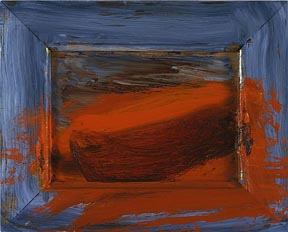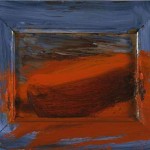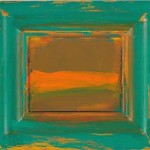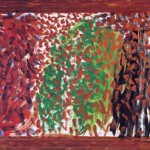Given that fine art, by character and presentation, is an objective venture; it would be futile to refute, but not to debate an artist’s concept which yields a contradiction between its aesthetic values and opposed to the object’s conceptual content. Perhaps the human brain is hardwired to make relations from all it witnesses, so only under the threat of some type of Orwellian circumstance, would a viewer see a red painting and describe it as a blue painting.
It comes as no surprise to me that I get an uneasy feeling when I read this quote by Howard Hodgkin, where he states that his paintings are “representational pictures of emotional situations". Two things strike me as odd in this quote; first he uses the term “pictures”. I’ll put it this way, almost all my friends are painters and most of them paint paintings but very few of them make “pictures”. The difference is that paintings hang in museums and pictures hang at your auntie’s house. Second, the tone of the quotation is somewhat condescending in its assumption that whatever reaction might overtake a viewer will not be equivalent to what thought or feeling Hodgkin demands the viewer to consider.
Hodgkin presents this idea pictorially by using a non-objective format of abstract painting. Hodgkin paintings are executed intuitively; suggesting that the titles are more random than the quote leads you to believe. It’s possible that they are not related at all and that this part of the artist’s process is a secondary concern.
“Howard Hodgkin: Paintings 1992-2007”, 1 FEBRUARY-1 APRIL, at the Yale Center for British Art, is a 15 year sojourn of this veteran painter’s career. The exhibition contains 61 paintings of varying scale and shape. Aided by the oversize elevator that gave way to the foyer of the exhibition, I noticed that both the entrance and exit walls had been treated with gold leaf paper sections. I didn’t realize their full implication until half way through the exhibition. Having these walls covered in gold leaf paper, which then frames one of Hodgkin’s large paintings, only reinforces the idea of Hodgkin’s paintings as objects. He regularly paints on wood, such as old doors and discarded table tops, almost always framed. His gestural mark is not confined to just the two-dimensional picture plane; he freely utilizes the frame as an extension of the painting. If a painting doesn’t physically have a frame added to it, Hodgkin will paint large brush strokes of color to suggest the object has one. This idea is more pertinent if you take the time to visit the second floor of the Museum, which houses an impressive collection of over 1,900 British paintings; from Hogarth to Turner. Aside from the wealth of this historical collection, it’s hard not to notice just how much gold leaf framing is in the collection.
Hodgkin makes references to other painters or paintings by the use of titles or techniques. Titles like “After Samuel Palmer”; “After Degas”, “After Vuillard” are more literal in their nature. In paintings such as “Bedroom Window”, or “Autumn” it would be hard to not read Hodgkin’s brush stroke as resembling the work of Pierre Bonnard. It’s true that when you pick up a paint brush you’ll experience the heavy weight of the history of painting. The level of your awareness in painting determines the weight. What’s so important to me in this context is Hodgkin’s syntax and just how effortlessly he makes the act of painting appear.
What perplexes me about Hodgkin’s work is just how vague the concept becomes after you immerse yourself in it. “Small Chez Max”, 18 inches in diameter, is a memorial painting for the architect, Max Gordon. I found nothing about this painting that would suggest the sentimentality of a memorial painting. Hodgkin actually made a total of three paintings dealing with this subject. “Small Chez Max”, 18” diameter, 1989-97; “Chez Max” 69” diameter, 1996-97, and “in Memory of Max Gordon, 1990-96, 94” X 74”; the latter two were not included in the exhibition. The title “in Memory of Max Gordon” directs you to the painting’s content and not an emotional situation. Here is a quote referring to “Chez Max” “… I was able to distance the subject even more from me than I might perhaps have been able to otherwise, and I think it’s therefore more intense than the other two”. The quote seems to contradict the basic premise of his concept. With all of my questioning and contemplation I’m just not persuaded that Hodgkin is being honest with his idea, which brings me to wonder about his sincerity but not about his ability to make beautiful paintings.
- Howard Hodgkin, Little Venice, oil on wood, 2003.
- Howard Hodgkin, Tribute, oil on wood, 2001-2002.
- Howard Hodgkin, Autumn, oil on wood, 1998-2003.
Links:
Yale Center for British Art
"Howard Hodgkin: Paintings 1992-2007" is on view until April 1st, at the Yale Center for British Art located at at Yale University, 1080 Chapel St., New Haven, CT.
All images are courtesy of the Artnet, Gagosian, LA, and Gasosian, NY.







